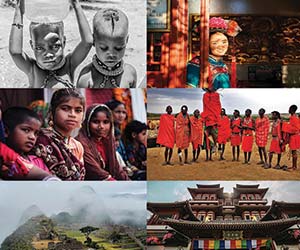The Way to Rainy Mountain
Select Format
Select Condition 
Book Overview
The Way to Rainy Mountain recalls the journey of Tai-me, the sacred Sun Dance doll, and of Tai-me's people in three unique voices: the legendary, the historical, and the contemporary. It is also the... This description may be from another edition of this product.
Format:Paperback
Language:English
ISBN:0826304362
ISBN13:9780826304360
Release Date:September 1976
Publisher:University of New Mexico Press
Length:88 Pages
Weight:0.50 lbs.
Dimensions:7.0" x 0.3" x 6.0"
Customer Reviews
6 ratings
Beautiful imagery
Published by Kenzie M. , 3 years ago
Momaday’s work is nothing short of extraordinary. 10/10. Amazing, beautiful, educational.
A timeless journey
Published by Thriftbooks.com User , 22 years ago
The Way to Rainy Mountain by N. Scott Momaday; illustrated by Al Momaday. Highly recommended.Rainy Mountain, a "single knoll [that] rises out of the plain in Oklahoma," is an old landmark for the Kiowa people. It is a land of bitter cold, searing heat, summer drought, and "great green and yellow grasshoppers." It is a land of loneliness, where the Kiowa were drawn after a long journey from the northwest through many types of lands.The Way to Rainy Mountain is about the journey-in myth, in drawings by Momaday's father Al, in reminiscences, and in historical snippets. All reveal aspects of Kiowa culture, life, philosophy, outlook, spirituality, and sense of self-the beauty and the desolation, how the introduction of the horse revolutionized Kiowa life, the story of Tai-me, and the richness of the word and the past. It is a literal journey as well; Momaday, in Yellowstone, writes, "The Kiowas reckoned their stature by the distance they could see, and they were bent and blind in the wilderness."This is a small gem of a book, beautifully written, illustrated, and designed. It has moments of insight, beauty, and sadness, as the ending of the Sun Dance, telling as the sun is at the heart of the Kiowa's soul-a soul that survives in every word and drawing of The Way to Rainy Mountain.Diane L. Schirf, 3 March 2002.
rich in history and image
Published by Thriftbooks.com User , 24 years ago
Momaday spins together pieces of Kiowa myth and image interweaved with tales he heard as a boy. Poetic, tragic, unforgettable.
Compelling reflections from personal & cultural memory
Published by Thriftbooks.com User , 24 years ago
Momaday's narrative comprises an elegy for Kiowa culture, drawn from his memories of his grandmother and other family members and from their memories of a culture now lost. And the book ends with a stunning poem, the likes of which one rarely finds in contemporary poetry. It's that closing poem that lifts this humble book into the realm of masterpiece. As Chaucer's Pandarus says, "Th'ende is every tale's strengthe."
This book changed my perspective on life
Published by Thriftbooks.com User , 26 years ago
The Way to Rainy Mountain is one of those rare books that changed my whole persepective of the world. The beauty of his style and simplicity of his stories show what a firm grasp and love of the language Dr. Momaday has. I had the priviledge of hearing Dr. Momaday speak recently. Much to my joy, he speaks much the same way he writes--in clear, simple phrases. He doesn't take language for granted. Instead he cherishes every syllable, every sound. But not only did this book teach me about the language, but about a culture. The way Dr. Momaday views the world, nature, and other people is truly fascinating and insightful. He is a spokesman for a rapidly diminishing world of orators and storytellers. This book will live in the hallowed halls of literature for countless generations.
A mythic voyage into the Kiowa spirit
Published by Thriftbooks.com User , 28 years ago
THE WAY TO RAINY MOUNTAIN is a fscinating account of the Kiowa spirit's core through the poet N Scott Momaday's three voices: the collective tribal story-telling voice, the historic voice (based on historical documentation), and the poet's own experiential voice (Momaday retraced the migratory route of his ancestors from Montana to Oklahoma). These three voices work on the reader's imagination to produce a fourth voice on the stage of the reader's mind. THE WAY TO RAINY MOUNTAIN depicts an epic journey of the Kiowa people through space (Montana southward) and time (mythological to modern). The ancient Kiowa's psyche fuses with primal nature be it with dog persons, antelope beings, or the mythological (but very real) creature called Taime.Once in Oklahoma the Kiowa mastered the horse and became among the best of hunters on the Great Plains. Brave in spirit, sharing in heart, they became a proud people. But European civilization closed in and all but crushed them by killing off the buffalo, killing herds of horses and turning hunters into farmers. Yet the Kiowa people held their vital contact with the land in today's hectic world: "Once in his life a man ought to concentrate his mind upon the remembered earth, I believe," writes Momaday. "He ought to give himself up to a particular landscape in his experience, to look at it from as many angles as he can, to wonder about it, to dwell upon it. He ought to imagine that he touches it with his hands at every season and listens to the sounds that are made upon it." Momaday helps the reader do just that--gain an appreciation for the multi-dimensional land of North America
The Way to Rainy Mountain Mentions in Our Blog

Reading Challenge: Reading About Different Cultures
Published by Bianca Smith • March 08, 2018
Living different lives, in the pages of books.






